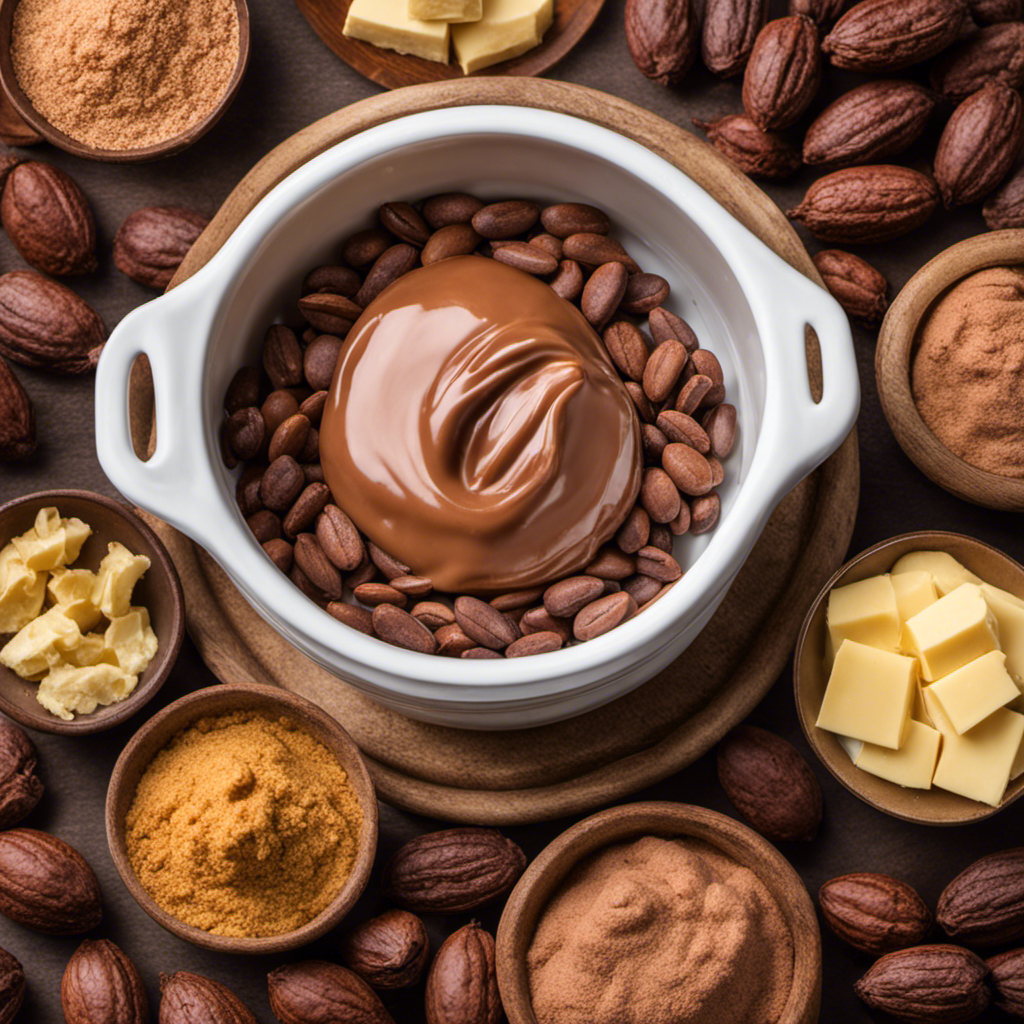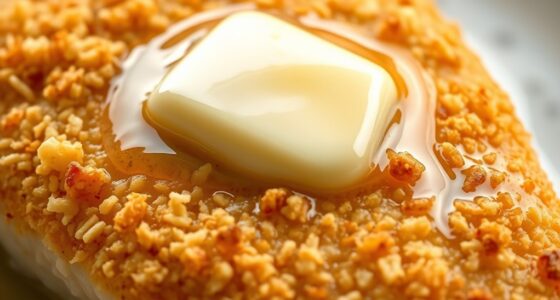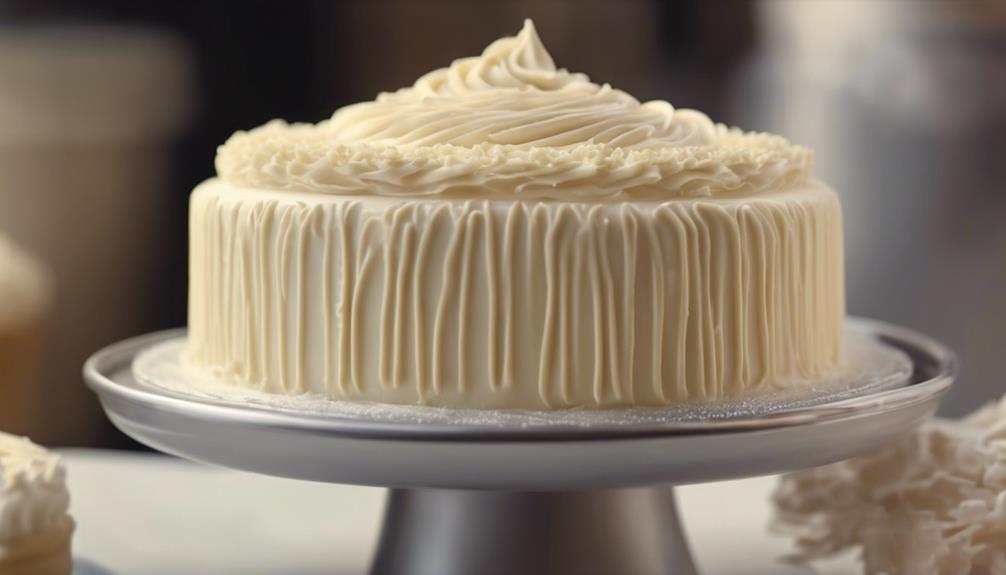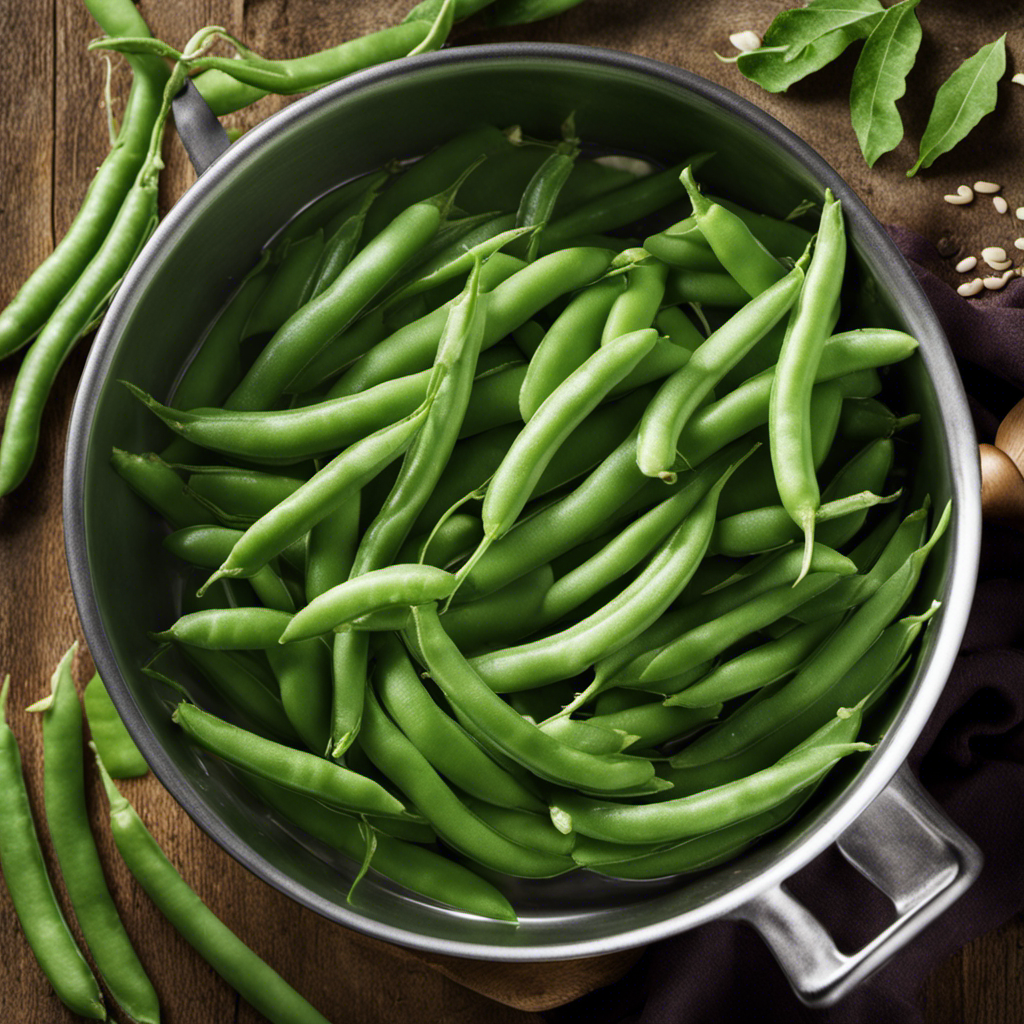I have always enjoyed the sensation of soft, hydrated skin, particularly in the harsh winter months. That’s why I chose to develop my own cocoa butter lotion.
In just a few simple steps, you too can make this luxurious and nourishing lotion right at home.
Gather the ingredients, melt the cocoa butter, add the carrier oils, and mix in essential oils for a delightful scent.
Don’t forget to incorporate a preservative if you want to extend the shelf life.
Get ready to indulge in the ultimate skin pampering experience!
Key Takeaways
- Cocoa butter is rich in antioxidants and deeply moisturizes the skin.
- There are two main techniques for melting cocoa butter: the double boiler method and the microwave method.
- Sweet almond oil, jojoba oil, coconut oil, avocado oil, and grapeseed oil are all great carrier oils for cocoa butter lotion.
- Essential oils can be added for fragrance and therapeutic benefits, but the use of preservatives is optional and has pros and cons.
Gather the Ingredients
Now, you’re going to gather all the ingredients needed for making cocoa butter lotion.
Cocoa butter is a powerful ingredient for skincare, known for its numerous benefits. It is rich in antioxidants, which help fight free radicals and protect the skin from environmental damage. Cocoa butter also has deeply moisturizing properties that can nourish and hydrate the skin, leaving it soft and supple.
In addition to making lotion, cocoa butter can be used in various DIY beauty products. It can be incorporated into lip balms, body butters, and even hair masks. Its versatility makes it a popular choice for those who prefer natural and homemade skincare solutions.
Melt the Cocoa Butter
When it comes to melting cocoa butter, there are various techniques and tips that can help achieve the best results.
As someone who has worked with cocoa butter extensively, I can share my knowledge and expertise on this topic.
In this discussion, we will explore different methods of melting cocoa butter and provide useful tips to ensure a smooth and successful process.
Melting Cocoa Butter: Techniques
To melt cocoa butter, you can use a double boiler or microwave. Both methods work well, but it’s important to know the right techniques to ensure the cocoa butter melts properly.
Here are some tips to help you melt cocoa butter effectively:
-
Double Boiler Method: Fill the bottom pot with water and place it on the stove. Heat the water until it simmers. Place the cocoa butter in the top pot and let it melt slowly over the simmering water.
-
Microwave Method: Cut the cocoa butter into small pieces and place them in a microwave-safe bowl. Heat the cocoa butter in 20-second intervals, stirring in between, until it melts completely.
-
Check the Temperature: The ideal cocoa butter melting temperature is around 104-113°F (40-45°C). Use a candy thermometer to monitor the temperature and avoid overheating.
-
Stir Frequently: Whether you’re using a double boiler or microwave, make sure to stir the cocoa butter frequently to ensure even melting.
-
Be Patient: Melting cocoa butter takes time, so be patient and avoid rushing the process. Rushing can result in uneven melting or burning the cocoa butter.
Cocoa Butter Melting Tips
Using a candy thermometer to monitor the temperature is essential for achieving the ideal consistency when melting cocoa butter. When melting cocoa butter, it is important to follow some tips and techniques to ensure a smooth and successful process. Here are some tips for melting cocoa butter effectively:
-
Use a double boiler: Place a heatproof bowl over a pot of simmering water. This gentle heat will melt the cocoa butter without scorching it.
-
Break it into small pieces: Smaller pieces of cocoa butter will melt more evenly and quickly, ensuring a smooth consistency.
-
Stir occasionally: Stirring the melted cocoa butter occasionally will help distribute the heat evenly and prevent any hot spots.
-
Maintain the temperature: Use a candy thermometer to monitor the temperature and keep it between 90°F and 100°F for the best results.
Add the Carrier Oils
After melting the cocoa butter, you’ll want to add the carrier oils to the mixture. Carrier oils are an essential component of making cocoa butter lotion, as they provide numerous benefits for the skin.
Here are some alternative carrier oils that you can consider adding to your lotion:
- Sweet almond oil: Known for its moisturizing properties and ability to soothe dry and irritated skin.
- Jojoba oil: Helps regulate oil production and is easily absorbed, making it suitable for all skin types.
- Coconut oil: Hydrates and nourishes the skin, leaving it soft and supple.
- Avocado oil: Rich in vitamins and antioxidants, it deeply moisturizes and rejuvenates the skin.
- Grapeseed oil: Lightweight and non-greasy, it helps tighten the skin and reduce the appearance of wrinkles.
By incorporating these carrier oils into your cocoa butter lotion, you can enhance its benefits and customize it to suit your specific skin needs.
Now, let’s move on to the next step: mixing in essential oils (optional).
Mix in Essential Oils (optional
Now, it’s time to add a few drops of your chosen essential oils to the mixture for added fragrance and therapeutic benefits.
Using essential oils in cocoa butter lotion can provide a range of benefits for your skin and overall well-being. The aroma of essential oils can uplift your mood, reduce stress and anxiety, and promote relaxation.
Additionally, many essential oils have properties that can help soothe and nourish the skin. Some popular options for cocoa butter lotion include lavender oil, which can promote skin healing and relaxation, and peppermint oil, known for its cooling and invigorating effects. Other choices include tea tree oil for its antibacterial properties, and chamomile oil for its calming and soothing effects.
Experiment with different essential oils to find the perfect blend for your needs and preferences.
Incorporate the Preservative (optional
To keep your homemade product fresh for longer, you can opt to incorporate a preservative into the mixture. While preservatives can extend the shelf life of your cocoa butter lotion, it is important to weigh the pros and cons before making a decision. Here are a few things to consider:
-
Pros of using preservatives:
-
Prevents the growth of harmful bacteria and mold
-
Increases the stability and effectiveness of the product
-
Allows for a longer shelf life, reducing waste
-
Provides peace of mind knowing your lotion is safe to use
-
Enables the addition of water-based ingredients without spoilage
-
Cons of using preservatives:
-
Some preservatives may cause skin irritation or allergic reactions
-
Natural and organic product enthusiasts may prefer preservative-free options
-
Preservatives can be seen as artificial additives by some consumers
-
Finding the right preservative and determining the correct amount can be challenging
-
Preservatives may have negative environmental impacts
Ultimately, the decision to incorporate preservatives into your cocoa butter lotion is a personal one. Consider your priorities, research different preservatives, and make an informed choice that aligns with your values and goals.
Pour and Store the Lotion
Once you’ve mixed all the ingredients together, simply pour the lotion into a clean, airtight container for storage.
It is important to choose the right storage container to ensure the longevity of your homemade cocoa butter lotion. Look for containers that are made of glass or opaque plastic, as they help protect the lotion from exposure to light, which can degrade the quality of the ingredients. Additionally, make sure the container has a tight-fitting lid to prevent air from entering and causing the lotion to spoil.
Proper storage is crucial for maintaining the shelf life of your lotion. Store it in a cool, dry place away from direct sunlight and extreme temperatures.
Following these guidelines will help preserve the quality of your cocoa butter lotion for an extended period of time.
Tips and Variations
If you’re looking for some creative ways to personalize your homemade lotion, there are a few tips and variations you can try. Here are some ideas to make your cocoa butter lotion even more special:
- Essential oils: Add a few drops of your favorite essential oils to give your lotion a pleasant scent. Lavender, peppermint, and citrus oils are popular choices.
- Herbal infusions: Infuse your cocoa butter lotion with herbs like chamomile, rosemary, or calendula to add extra skincare benefits and a natural fragrance.
- Exfoliating additives: Mix in some finely ground oats, sugar, or coffee grounds to create a gentle exfoliating lotion that helps remove dead skin cells.
- Skin-nourishing ingredients: Enhance the moisturizing properties of your lotion by incorporating ingredients like shea butter, coconut oil, or vitamin E oil.
- Natural colorants: Explore natural colorants like beetroot powder or cocoa powder to give your lotion a beautiful hue without any artificial additives.
Using different types of cocoa butter lotions offers various benefits for your skin. Cocoa butter is deeply moisturizing and helps improve skin elasticity, making it an excellent choice for dry or mature skin. It also contains antioxidants that can help reduce the signs of aging and protect your skin from environmental damage. Additionally, cocoa butter has been known to soothe skin irritations and promote a healthy complexion.
Frequently Asked Questions
How Long Does Homemade Cocoa Butter Lotion Last Before It Expires?
The shelf life of homemade cocoa butter lotion varies, but it generally lasts for about 6-12 months before it expires. It’s important to check for any changes in smell, texture, or color as an indication of spoilage.
Can I Substitute Cocoa Butter With Another Type of Butter in This Recipe?
Yes, you can substitute cocoa butter with another type of butter in this recipe. However, keep in mind that cocoa butter has unique benefits for the skin, such as its moisturizing and nourishing properties.
Are There Any Potential Allergic Reactions to Using Cocoa Butter Lotion?
There may be potential side effects when using cocoa butter lotion, such as skin irritation or allergic reactions. If you’re concerned, consider trying alternative moisturizer options like shea butter or coconut oil.
Can I Use This Lotion on My Face as Well as My Body?
Sure, I can use cocoa butter lotion on my face. It’s great for moisturizing and nourishing the skin. Compared to other facial moisturizers, cocoa butter lotion offers excellent benefits without any harsh chemicals. It’s a win-win!
Can I Add Color or Shimmer to the Lotion for a More Aesthetic Appeal?
Yes, you can add color or shimmer to homemade cocoa butter lotion to enhance its aesthetic appeal. There are different ways to achieve this, such as using mica powders or cosmetic-grade colorants.
Conclusion
In conclusion, making your own cocoa butter lotion is like crafting a decadent masterpiece for your skin.
With a few simple steps, you can melt the cocoa butter into a luxurious concoction that will leave your skin feeling nourished and hydrated.
By adding carrier oils, essential oils, and a preservative if desired, you can customize your lotion to suit your preferences.
So go ahead and indulge in the art of lotion making, and let your skin be swept away by the velvety goodness of cocoa butter.
Your skin will thank you for it!










